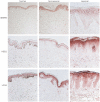IL-17 induces an expanded range of downstream genes in reconstituted human epidermis model
- PMID: 24587313
- PMCID: PMC3938679
- DOI: 10.1371/journal.pone.0090284
IL-17 induces an expanded range of downstream genes in reconstituted human epidermis model
Abstract
Background: IL-17 is the defining cytokine of the Th17, Tc17, and γδ T cell populations that plays a critical role in mediating inflammation and autoimmunity. Psoriasis vulgaris is an inflammatory skin disease mediated by Th1 and Th17 cytokines with relevant contributions of IFN-γ, TNF-α, and IL-17. Despite the pivotal role IL-17 plays in psoriasis, and in contrast to the other key mediators involved in the psoriasis cytokine cascade that are capable of inducing broad effects on keratinocytes, IL-17 was demonstrated to regulate the expression of a limited number of genes in monolayer keratinocytes cultured in vitro.
Methodology/principal findings: Given the clinical efficacy of anti-IL-17 agents is associated with an impressive reduction in a large set of inflammatory genes, we sought a full-thickness skin model that more closely resemble in vivo epidermal architecture. Using a reconstructed human epidermis (RHE), IL-17 was able to upregulate 419 gene probes and downregulate 216 gene probes. As possible explanation for the increased gene induction in the RHE model is that C/CAAT-enhancer-binding proteins (C/EBP) -β, the transcription factor regulating IL-17-responsive genes, is expressed preferentially in differentiated keratinocytes.
Conclusions/significance: The genes identified in IL-17-treated RHE are likely relevant to the IL-17 effects in psoriasis, since ixekizumab (anti-IL-17A agent) strongly suppressed the "RHE" genes in psoriasis patients treated in vivo with this IL-17 antagonist.
Conflict of interest statement
Figures



Similar articles
-
IL-4 Downregulates IL-1β and IL-6 and Induces GATA3 in Psoriatic Epidermal Cells: Route of Action of a Th2 Cytokine.J Immunol. 2015 Aug 15;195(4):1744-52. doi: 10.4049/jimmunol.1401740. Epub 2015 Jul 13. J Immunol. 2015. PMID: 26170379
-
Calcipotriol and betamethasone dipropionate exert additive inhibitory effects on the cytokine expression of inflammatory dendritic cell-Th17 cell axis in psoriasis.J Dermatol Sci. 2016 Mar;81(3):153-64. doi: 10.1016/j.jdermsci.2015.12.009. Epub 2015 Dec 23. J Dermatol Sci. 2016. PMID: 26794805
-
IL-17A and IFN-γ synergistically induce RNase 7 expression via STAT3 in primary keratinocytes.PLoS One. 2013;8(3):e59531. doi: 10.1371/journal.pone.0059531. Epub 2013 Mar 21. PLoS One. 2013. PMID: 23555696 Free PMC article.
-
Interleukin-17A and Keratinocytes in Psoriasis.Int J Mol Sci. 2020 Feb 13;21(4):1275. doi: 10.3390/ijms21041275. Int J Mol Sci. 2020. PMID: 32070069 Free PMC article. Review.
-
Psoriasis and other Th17-mediated skin diseases.J UOEH. 2010 Dec 1;32(4):317-28. doi: 10.7888/juoeh.32.317. J UOEH. 2010. PMID: 21226422 Review.
Cited by
-
Effect of Adalimumab on Gene Expression Profiles of Psoriatic Skin and Blood.J Drugs Dermatol. 2016 Aug 1;15(8):988-94. J Drugs Dermatol. 2016. PMID: 27538000 Free PMC article.
-
Therapeutic Implication of SOCS1 Modulation in the Treatment of Autoimmunity and Cancer.Front Pharmacol. 2019 Apr 11;10:324. doi: 10.3389/fphar.2019.00324. eCollection 2019. Front Pharmacol. 2019. PMID: 31105556 Free PMC article. Review.
-
Second-Strand Synthesis-Based Massively Parallel scRNA-Seq Reveals Cellular States and Molecular Features of Human Inflammatory Skin Pathologies.Immunity. 2020 Oct 13;53(4):878-894.e7. doi: 10.1016/j.immuni.2020.09.015. Immunity. 2020. PMID: 33053333 Free PMC article.
-
The expression and regulation of chemerin in the epidermis.PLoS One. 2015 Feb 6;10(2):e0117830. doi: 10.1371/journal.pone.0117830. eCollection 2015. PLoS One. 2015. PMID: 25659101 Free PMC article.
-
A Novel Catecholopyrimidine Based Small Molecule PDE4B Inhibitor Suppresses Inflammatory Cytokines in Atopic Mice.Front Pharmacol. 2018 May 11;9:485. doi: 10.3389/fphar.2018.00485. eCollection 2018. Front Pharmacol. 2018. PMID: 29867490 Free PMC article.
References
-
- Harrington LE, Hatton RD, Mangan PR, Turner H, Murphy TL, et al. (2005) Interleukin 17-producing CD4+ effector T cells develop via a lineage distinct from the T helper type 1 and 2 lineages. Nat Immunol 6: 1123–32. - PubMed
-
- Ortega C, Fernandez AS, Carrillo JM, Romero P, Molina IJ, et al. (2009) IL-17-producing CD8+ T lymphocytes from psoriasis skin plaques are cytotoxic effector cells that secrete Th17-related cytokines. J Leukocyte Biol 86: 435–43. - PubMed
MeSH terms
Substances
Grants and funding
LinkOut - more resources
Full Text Sources
Other Literature Sources
Molecular Biology Databases
Research Materials

